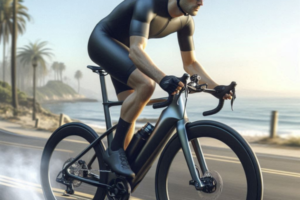🌬️ Simulation Technologies to Improve the Aerodynamics of Electric Bicycles in Coastal Cities
As urban mobility transforms along the humid coastlines of the world, electric bicycles (e-bikes) have emerged as a clean, agile, and sustainable solution. Yet, in cities shaped by sea breezes, high humidity, and unpredictable wind tunnels between buildings, one design factor becomes essential: aerodynamics. This is where simulation technologies to improve the aerodynamics of electric bicycles are proving to be a game-changer — enabling engineers to fine-tune performanc…
Unlike traditional bicycles, e-bikes are equipped with added components such as battery housings, hub motors, control displays, and rear cargo racks — all of which increase the frontal surface area and, consequently, the aerodynamic drag. In coastal environments where wind speed and humidity fluctuate daily, drag doesn’t just slow a ride; it drains battery life, destabilizes the rider, and creates fatigue over time. A poorly designed e-bike can struggle against ocean winds, while an aerodynamic one g…
Aerodynamics refers to how air flows around a moving object. In the context of e-bikes, it’s about managing how wind interacts with every detail — from the shape of the frame and the rider’s body posture to external accessories like panniers and mudguards. Minimizing drag results in smoother, safer, and more energy-efficient rides. Research shows that optimizing aerodynamic flow can increase battery range by up to 15% and significantly reduce the strain placed on both rider and motor.
For e-bike manufacturers and urban planners, especially in coastal cities like Miami, Barranquilla, or Lisbon, simulation tools are becoming indispensable. They eliminate the need to rely on physical prototypes by creating virtual test environments that replicate real-world coastal wind conditions, humidity levels, and urban terrain. By using these tools, designers can simulate how changes to shape, angle, or component placement affect performance — all before a single screw is tightened.
Among the most valuable of these tools is Computational Fluid Dynamics (CFD). CFD allows engineers to digitally observe how air travels around the entire e-bike, highlighting pressure zones, turbulence, and wake areas that increase resistance. With CFD, simulations can reveal how a front-mounted light may disrupt airflow, or how integrating the battery into the downtube significantly reduces frontal drag compared to a rear-rack configuration.
💡 Did you know? In humid air, the density is slightly lower than in dry air — but its viscosity is higher. This means that drag behaves differently in coastal cities compared to inland areas. CFD simulations that include humidity as a factor help designers ensure their bikes are optimized for the exact conditions riders will face.
In the past, developing a new e-bike meant multiple physical prototypes, each with its own cost and environmental footprint. Today, simulation technologies empower design teams to test hundreds of aerodynamic configurations digitally — dramatically reducing material waste and development time. For small manufacturers, this approach opens the door to competitive innovation without the need for large R&D budgets.
Simulation also has implications for safety. Sudden gusts between coastal high-rises or crosswinds on oceanfront roads can easily destabilize a bike. By using simulation models that incorporate real-world environmental data, designers can anticipate these risks and adapt the geometry, rider posture, and weight distribution for better control. For everyday riders, this translates into smoother, more predictable handling — even when conditions are harsh.
Simulation is more than a trend; it’s a silent revolution shaping the next generation of e-mobility. As these technologies become more accessible, we can expect to see even mid-range electric bikes benefit from features once limited to high-performance racing models. In coastal cities where infrastructure, weather, and sustainability goals intersect, the role of simulation will only grow more vital.
🌊 Coastal Insight: Riders in Cartagena, Colombia, reported that e-bikes redesigned using aerodynamic simulations experienced fewer motor overheating issues during afternoon commutes — when both temperature and humidity peak. Small tweaks, big impact.
🚴♂️ Inspirational Note: “The wind is not your enemy — it’s a force you can design with.” That’s the philosophy behind every simulation-driven design. And it’s changing how we ride, one gust at a time.
🛠️ Evolving E-Bike Design: From Traditional Prototypes to Simulation Technologies
Until recently, developing an electric bicycle meant constructing multiple physical prototypes, each one tested manually and modified through trial-and-error. This process was costly, time-consuming, and limited in scope — especially for small manufacturers without access to wind tunnels or specialized testing facilities. But thanks to simulation technologies to improve the aerodynamics of electric bicycles, this landscape is shifting dramatically, particularly for brands operating in co…
Digital tools like Computational Fluid Dynamics (CFD), 3D airflow mapping, and digital wind tunnel testing allow designers to simulate real-world riding conditions in a virtual environment. This includes modeling coastal breezes, fluctuating humidity, and even how airflow changes during rush hour traffic in tight urban corridors. Through these simulations, engineers can evaluate the aerodynamic efficiency of every component — from the battery casing and display unit to cargo racks and pannier shape…
📊 Traditional Design vs. Simulation-Based Innovation
| Feature | Traditional Development | Simulation-Based Development |
|---|---|---|
| Prototyping Cost | High: physical materials, labor, tools | Low: digital modeling only |
| Time per Iteration | Weeks or months | Hours to days |
| Number of Configurations Tested | Limited | Unlimited virtual variations |
| Environmental Replication | Generic wind tunnel setup | Real city wind, humidity, and terrain |
| Accessibility for Small Brands | Restricted | Empowered by open-source tools |
These advantages aren’t theoretical — they translate into tangible benefits for everyday riders. With better aerodynamics, battery life is extended, ride control is improved, and fatigue is reduced. This is especially true in humid cities by the sea, where salt particles in the air increase mechanical wear and wind variability affects ride dynamics.
✅ Aerodynamic Optimization Checklist for Coastal E-Bike Designers
- ✔️ Integrate battery into downtube rather than rear rack.
- ✔️ Streamline handlebar-mounted displays.
- ✔️ Curve panniers to match wheel profiles.
- ✔️ Model wind flow around fenders and lighting systems.
- ✔️ Simulate posture variations in humid, windy settings.
These simulation-backed decisions can be the difference between a mediocre design and one optimized for real coastal life. A curved pannier can reduce wake zones; a tapered head tube can lower frontal drag; a better-angled seat can help stabilize riders during sudden gusts near ocean roads. All of these enhancements stem from digital tools now available to even independent builders.
💡 Coastal Design Tip: When simulating airflow for humid cities, always include microclimatic data such as early morning fog, sea breeze acceleration in the afternoon, and heat pockets around urban intersections. These factors affect not only comfort but battery output and gear reliability.
For riders navigating routes through seaside parks, harborfront roads, or narrow coastal alleys, these small adjustments mean greater speed, less strain, and more joy. The magic lies in the invisible — in how air flows over you and your ride, and in how smart design channels it to your advantage.
🚴♂️ Fine-Tuning E-Bike Components: Simulation for Micro-Aerodynamic Gains
While frame geometry and rider posture often take center stage in aerodynamic discussions, the truth is that small components can make a big difference — especially in coastal cities where wind behavior is unpredictable and intensified by buildings, sea cliffs, and temperature-driven breezes. Fortunately, simulation technologies to improve the aerodynamics of electric bicycles are now detailed enough to evaluate these microelements with precision.
Consider how even a simple front light can affect performance. A protruding cylindrical light mounted on the handlebars may seem harmless, but when simulated in a digital wind tunnel, it can be shown to disrupt airflow across the top tube and cause a localized pressure spike. Repositioning or integrating the light into the stem housing can restore laminar flow, improving both stability and energy efficiency.
The same principle applies to grips, pedals, racks, and even bolts. In humid environments, these details matter even more. Salt particles in the air slightly increase surface texture through corrosion, which in turn alters how air slips across the frame. Simulation tools like CFD can now model how materials behave in real-world salty, wet conditions — helping designers choose not just shapes but surface finishes that work better by the sea.
📌 Real Case Highlight: Aerodynamic Overhaul in a Coastal Cargo E-Bike
A Portuguese startup designing cargo e-bikes for Lisbon’s waterfront made a breakthrough after running simulations on the aerodynamic drag caused by their side-mounted storage units. The original boxy containers created high-drag wake zones when hit by sidewinds coming off the Atlantic. Using CFD, the team redesigned the containers with curved edges and relocated them slightly rearward.
The result? A 22% reduction in drag from crosswinds and a 13% increase in range per charge. More importantly, rider confidence improved dramatically, with fewer reports of balance loss during turns. What began as a small simulation experiment turned into a redesign that elevated the brand’s reputation for stability and control in wind-prone regions.
This story isn’t unique. Dozens of independent manufacturers in Latin America, Southeast Asia, and the Mediterranean are now using simulation to differentiate their e-bikes for local conditions. From wind-deflecting panniers in Cartagena to fork-shaped spoilers in Bali, the micro-aerodynamic revolution is underway — powered by accessible digital tools and data-driven creativity.
✨ Design Insight: “Every component, no matter how small, either helps you ride with the wind or fights against it. When we treat bolts, bags, and lights as part of the airflow system, we begin to unlock a whole new level of efficiency.”
What’s exciting is how simulation democratizes this level of design. Previously, only top-tier race teams had access to fine-grained wind modeling. Today, with intuitive interfaces and cloud-based processing, even community-led e-bike projects can simulate how an integrated rear light compares to a side mount — and make a better decision based on real data.
It’s also a matter of environmental justice. In many coastal areas, affordable transportation options are limited. By helping small builders create bikes that last longer, perform better, and cost less to operate, simulation technologies aren’t just optimizing performance — they’re empowering communities.
Another overlooked factor is rider gear. Coastal commuters often wear rain-resistant jackets or carry waterproof backpacks — both of which can alter drag. Through simulation, designers and even cyclists themselves can understand how apparel choices affect efficiency. In fact, some high-end simulations now allow for virtual mannequins dressed in different outfits to test posture, size, and garment behavior under wind stress.
From a sustainability perspective, the ability to test component layouts digitally means fewer discarded prototypes and less reliance on trial-and-error with physical materials. This not only saves resources but also accelerates development cycles. For coastal regions where climate resilience and green infrastructure are top priorities, every gram of CO₂ saved in production matters — and simulation plays a direct role in making that possible.
🌟 Words to Ride By: “Simplicity is aerodynamic. When we reduce clutter, align our components with the wind, and design with intention, every ride becomes more fluid — and more free.”
🔄 Digital Twins and Environmental Simulation for Coastal Efficiency
As electric bicycles become smarter and more integrated into modern urban ecosystems, a new frontier in simulation is emerging: digital twins. These dynamic virtual replicas of physical bikes receive live data from embedded sensors and simulate performance in real-time. Combined with simulation technologies to improve the aerodynamics of electric bicycles, digital twins allow riders and manufacturers to understand — and even predict — how wind, humidity, rider posit…
Imagine riding along a seaside boulevard in a city like Rio de Janeiro or Miami. Your e-bike is equipped with sensors that monitor tilt, wind speed, rider posture, and vibration. This data is instantly fed into the cloud-based digital twin, which runs simulations to identify if your current setup is facing excessive drag. If so, it may recommend adjusting posture, changing speed, or even reducing the weight distribution to regain optimal aerodynamic flow.
Digital twins also provide manufacturers with valuable post-market feedback. If hundreds of users in coastal towns experience battery drain under similar conditions, engineers can analyze real usage patterns, identify friction points, and refine designs in the next model. This is particularly important in humid climates where salt, mist, and temperature changes can subtly but steadily degrade performance over time.
Beyond real-time applications, environmental simulation has become central in the design phase. Platforms now allow designers to input exact climate conditions — such as Cartagena’s midday humidity or Lisbon’s evening sea gusts — and see how bikes perform in those scenarios. By simulating airflow around buildings, across terrain gradients, and through vehicle corridors, designers ensure that each model isn’t just technically functional — it’s geographically optimized.
🌬️ Energy Efficiency Meets Coastal Sustainability
One of the most direct benefits of improved aerodynamics is energy conservation. In coastal cities where electricity prices may vary or be tied to limited infrastructure, every watt saved matters. By reducing drag, bikes need less power from their motors to maintain cruising speeds, extending battery range and decreasing the number of charges needed per week.
Studies have shown that a 10% aerodynamic improvement can yield a 7–12% range gain, depending on terrain and wind exposure. In cities where riders frequently encounter sidewinds or alternating wind corridors, these savings compound. Riders can go farther, faster, and recharge less — reducing electricity demand and extending battery lifespans.
💡 Eco Tip: In high-humidity zones, aerodynamics also supports heat management. Less drag means less motor strain, which translates into cooler system temperatures — a crucial advantage in regions where air moisture affects cooling efficiency.
🌐 Community Impact: “We used to replace our batteries every 10 months. After we redesigned using simulation to improve airflow and heat dispersion, they last over a year — even in Panama’s coastal heat.” — E-bike Fleet Manager, Local Delivery Service.
These improvements aren’t limited to individual riders. Municipal bike-sharing systems in coastal cities are now embracing simulation-informed e-bikes for their fleets. Not only do they reduce maintenance costs, but they also provide a more reliable service to residents and tourists — many of whom are unfamiliar with how crosswinds can affect bike control and safety.
Simulation is also bridging the gap between sustainability and performance. Less drag means fewer charge cycles, and fewer charge cycles mean longer battery life and less electronic waste — a critical factor in building coastal resilience. In fact, cities investing in smart mobility see simulation as a cornerstone of broader green transition strategies.
Looking ahead, the combination of real-time simulation, digital twin technology, and geographic-specific modeling promises a new generation of e-bikes that adapt instinctively to their environments. Riders in coastal zones will no longer need to guess how to ride efficiently — their bikes will help guide them, making commuting smarter, greener, and safer.
🌱 Inspirational Thought: “Technology should adapt to the wind — not the other way around. When design follows nature’s rhythm, the ride becomes harmony, not resistance.”
💬 Common Questions About E-Bike Aerodynamics and Simulation
❓ How do simulation technologies improve everyday riding?
They help designers create bicycles that cut through the wind more efficiently, improving speed, extending battery range, and enhancing rider control — especially in coastal cities with unpredictable breezes and humidity.
❓ Are these simulations only for big manufacturers?
Not anymore. Many tools are open source or low-cost, allowing small brands, educators, and even DIY enthusiasts to simulate airflow and improve designs without physical wind tunnels or large R&D budgets.
❓ Can aerodynamic design help with battery life?
Yes. By reducing drag, the motor needs less power to maintain speed, which translates into longer battery duration, fewer charge cycles, and overall lower energy consumption — a win for both users and the planet.
❓ Is it worth optimizing small parts like lights and racks?
Absolutely. Microcomponents can significantly affect airflow. Simulations often reveal that small adjustments (like repositioning a light or reshaping a pannier) can yield surprising gains in stability and efficiency.
❓ Do these tools consider weather factors like humidity and sea air?
Modern simulations can integrate environmental data such as humidity, wind patterns, and temperature variations, making them highly relevant for coastal riders and tropical environments.
🌟 Building a Community of Smarter Cyclists
Simulation technologies are not just tools for engineers — they are bridges between innovation and people. Every digital test, every airflow map, and every data-driven adjustment leads to a better, safer, and more enjoyable ride for someone navigating the curves of a coastal road or the wind tunnels between seaside buildings.
We believe in the power of shared knowledge. If you’re a rider, designer, or enthusiast who has experienced how wind affects your commute, your speed, or your comfort, share your story. Your insight might inspire the next great innovation — or simply help someone else ride with more confidence tomorrow.
🌍 Join the Movement: Leave a comment below with your experiences riding an e-bike in windy or humid conditions. How did you adapt? What changes made the biggest difference? Let’s grow together — one aerodynamic idea at a time.
🚴♀️ Final Reflections: Ride With the Wind
In coastal cities, riding an e-bike is more than transportation — it’s a dance with the elements. Sea air, ocean winds, shifting humidity — they all shape the journey. With simulation technologies to improve the aerodynamics of electric bicycles, we no longer have to struggle against nature; we can ride in sync with it.
From battery savings to stability gains, from real-time alerts to invisible microadjustments, simulation is silently enhancing the electric cycling experience. It’s not just about performance — it’s about harmony, safety, and sustainability.
So the next time you feel the breeze on your face as you glide along a coastal path, know that behind that graceful movement is a symphony of data, design, and innovation — all working together to help you ride further, smarter, and freer.
🎓 Empowering Through Education and Accessibility
One of the most exciting outcomes of simulation technology is how it levels the playing field. Today, simulation is no longer confined to corporate R&D labs — it’s being taught in classrooms, community bike shops, and online workshops around the world. High school students in coastal towns can now learn the fundamentals of airflow, riders can visualize how posture changes drag, and local bike builders can improve frame geometry using free or low-cost tools.
In places like Barranquilla and Valparaíso, educational programs are integrating simplified simulation models into public transportation initiatives. These programs not only teach science and design but also empower citizens to shape the future of mobility in their communities. By democratizing access to aerodynamic insights, we unlock creativity, innovation, and resilience — especially in the face of climate change.
📣 Quote to Remember: “The wind will always blow — but thanks to simulation, we’ve learned how to dance with it.”



